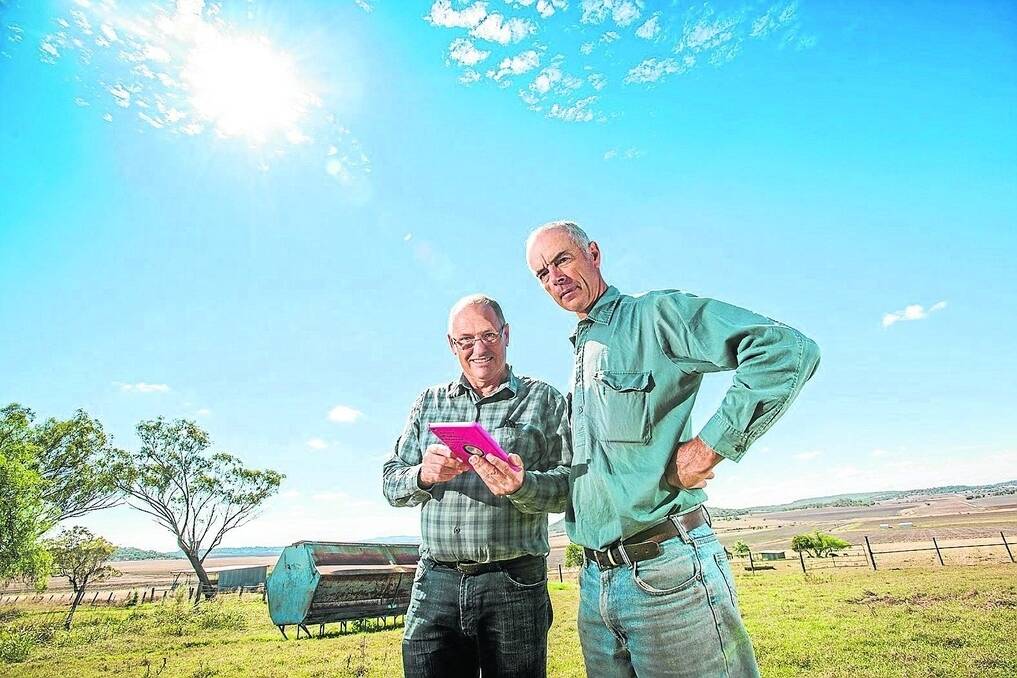
GUESSWORK can prove an expensive gamble in broadacre cropping, but Queensland-designed mobile technology is hoping to iron out some of those uncertainties.
The University of Southern Queensland's National Centre for Engineering is close to releasing a new soil-moisture app which helps farmers make a more informed decision about when they should plant.
The SoilWaterApp or SWApp, has been called Australia's most advanced soil moisture-calculation tool. Developed by USQ with funding by the Grains Research and Development Corporation (GRDC), SWApp aims to increase crop yields and profits by helping growers make more informed cropping decisions such as whether to plant or fallow, and how much pre-plant nitrogen to apply.
The app works by using climate data from the Bureau of Meteorology, and on-farm rainfall figures as well as crop-residue cover and soil-type information entered via a series of menus.
The app requires a starting value of moisture, given as a percentage of a full profile at harvest, and then looks at climate and rainfall data over the fallow period. It can also incorporate estimates of soil water from sources like EM mapping, capacitance probes and soil coring.
The app's key developers include Dr David Freebairn and Dr Brett Robinson from the National Centre for Engineering in Agriculture, part of USQ's Institute for Agriculture and the Environment (IAgE).
Dr Robinson said SWApp differed from predecessors such as CliMate and HowWet? by incorporating on-farm rainfall figures and paddock specifics to give the clearest picture yet of a crop's viability and requirements.
"SoilWaterApp allows you to measure or deduce how much moisture is in the soil before you plant, and for winter crops, that can be 30 to 70 per cent of the crop's entire water supply," Dr Freebairn said.
"As scientists, we have had complex models of rainfall and soil water on our big clunky computers for a long time and farmers have the experience and paddock knowledge necessary to interpret their rainfall patterns. Now they can be brought together on a phone in the paddock with this app," Dr Robinson said.
Darling Downs farmer Rob McCreath has used SWApp to get a clearer picture of winter-cropping prospects on a paddock he is considering double-cropping on his Felton property Prestbury.
"There are still lots of unknowns in regards to what the weather coming up will be, but the app does make it easier to decide what to do by pulling all the information together," Mr McCreath said.
Dr Robinson ran through the working of the app on-farm with Mr McCreath recently. When SWApp was downloaded, it automatically picked up historical and forecast data related to the bureau's Cambooya weather station, the closest BoM site to Prestbury.
When combined with information entered by Mr McCreath, which included a post-harvest soil moisture estimate of 10-20 per cent, a soil-type definition and a stubble-cover description, it came up with a soil moisture figure of 30mm in the profile, mostly in the top 300mm of soil. "What we looked at was a paddock of sorghum stubble, because I'm trying to decide if there's enough moisture in it to grow chickpeas," he said.
Using a soil-moisture probe and some educated guessing, Mr McCreath estimated there was soil-moisture to a depth of 200-400mm across the paddock on his property.
"The app came out with a figure close to what I had in my head, but the graphing of where that moisture is spread is what's really useful, and it's what I really like about the app.
"It gives you support in your decision-making if you and it come to a similar conclusion, and if it disagrees with you, then you can go over your logic and rethink some of the aspects that have affected your ideas about soil moisture."
Each year Mr McCreath and his wife Sally crop about 350 hectares, with up to 100 hectares double-cropped, on Prestbury.
Mr McCreath said deciding whether to plant was one of the biggest decisions on the cropping calendar, and SWApp's ability to assist with that, as well as to indicate how much yield potential the crop had, made it a worthwhile tool for farmers to consider.
"For a wheat crop, the more moisture you have, the more fertiliser you would put on, and the app helps you look ahead for the next couple of months when you're getting ready to plant to get an idea of your yield potential," he said.
Mr McCreath's feeling that another 50mm at least was required to plant chickpeas into sorghum stubble was confirmed by running SWApp."
The calculation estimates how much moisture is available and where it is in the soil profile, and that's really useful," Mr McCreath said.
IAgE executive director Steven Raine described the app as a significant step forward for farming in a variable climate.
"SWApp is a USQ Future Farm product which pulls together historical data and up-to-the-minute information about paddock soil water on a platform that farmers and consultants can use when and where it suits them," Professor Raine said.
The app is still in the fine-tuning phase and Dr Robinson said they were keen for users to give it a go and provide feedback.
Broadacre farmers with an iPhone or iPad interested in trialling SWApp free of charge should visit www.soilwaterapp.net.au to find out more and register.

